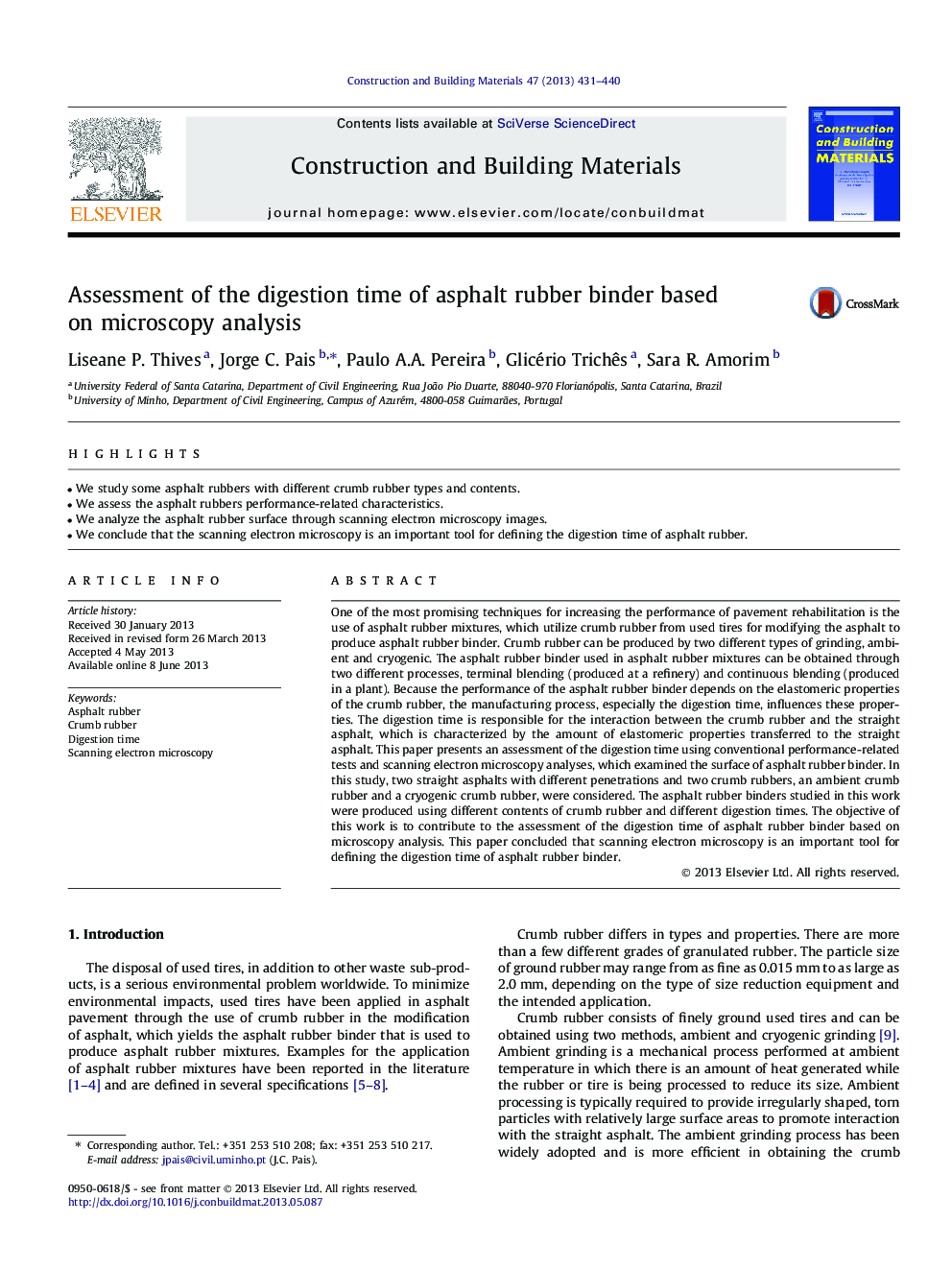| کد مقاله | کد نشریه | سال انتشار | مقاله انگلیسی | نسخه تمام متن |
|---|---|---|---|---|
| 6725488 | 503610 | 2013 | 10 صفحه PDF | دانلود رایگان |
عنوان انگلیسی مقاله ISI
Assessment of the digestion time of asphalt rubber binder based on microscopy analysis
ترجمه فارسی عنوان
بررسی زمان هضم گیربکس لاستیکی آسفالت بر اساس تجزیه و تحلیل میکروسکوپ
دانلود مقاله + سفارش ترجمه
دانلود مقاله ISI انگلیسی
رایگان برای ایرانیان
کلمات کلیدی
لاستیک آسفالت، لاستیک خرده نان، زمان هضم میکروسکوپ الکترونی اسکن،
ترجمه چکیده
یکی از تکنیک های امیدوار کننده برای افزایش توان عملیاتی احداث آسفالت، استفاده از مخلوط های لاستیکی آسفالتی است که از لاستیک خرد شده از لاستیک های مورد استفاده برای اصلاح آسفالت برای تولید باند لاستیک آسفالت استفاده می شود. لاستیک خرده نان را می توان با دو نوع مختلف سنگ زنی، محیط و فریزر تولید کرد. گیربکس لاستیکی آسفالت مورد استفاده در مخلوط لاستیکی آسفالت می تواند از طریق دو فرایند مختلف، ترکیب ترمینال (تولید شده در یک پالایشگاه) و ترکیب پیوسته (تولید شده در یک گیاه) به دست آید. از آنجا که عملکرد گیربکس لاستیکی آسفالت به خواص الاستومری از لاستیک خرده خرده بستگی دارد، فرایند تولید، به خصوص زمان هضم، بر این ویژگی ها تاثیر می گذارد. زمان هضم مسئول تعامل بین لاستیک خرد شده و آسفالت مستقیم است که توسط مقدار خواص الاستومری که به آسفالت مستقیم منتقل می شود مشخص می شود. این مقاله ارزیابی زمان هضم را با استفاده از آزمون های مرتبط با عملکرد معمول و تجزیه و تحلیل میکروسکوپ الکترونی اسکن، که سطوح گیربکس لاستیک آسفالت را مورد بررسی قرار می دهد. در این مطالعه، دو آسفالت مستقیم با نفوذ مختلف و دو رگه کریستالی، یک لاستیک کریستال محیطی و یک لاستیک کریستالی فریزر مورد بررسی قرار گرفتند. اتصال دهنده های لاستیکی آسفالت مورد مطالعه در این کار با استفاده از محتویات مختلف لاستیک خرد شده و زمان های مختلف هضم تولید می شود. هدف از این کار کمک به ارزیابی زمان هضم گیرنده لاستیک آسفالت بر اساس تجزیه و تحلیل میکروسکوپ است. این مقاله نتیجه گیری می کند که میکروسکوپ الکترونی اسکن یک ابزار مهم برای تعیین زمان هضم گیرنده لاستیک آسفالت است.
موضوعات مرتبط
مهندسی و علوم پایه
سایر رشته های مهندسی
مهندسی عمران و سازه
چکیده انگلیسی
One of the most promising techniques for increasing the performance of pavement rehabilitation is the use of asphalt rubber mixtures, which utilize crumb rubber from used tires for modifying the asphalt to produce asphalt rubber binder. Crumb rubber can be produced by two different types of grinding, ambient and cryogenic. The asphalt rubber binder used in asphalt rubber mixtures can be obtained through two different processes, terminal blending (produced at a refinery) and continuous blending (produced in a plant). Because the performance of the asphalt rubber binder depends on the elastomeric properties of the crumb rubber, the manufacturing process, especially the digestion time, influences these properties. The digestion time is responsible for the interaction between the crumb rubber and the straight asphalt, which is characterized by the amount of elastomeric properties transferred to the straight asphalt. This paper presents an assessment of the digestion time using conventional performance-related tests and scanning electron microscopy analyses, which examined the surface of asphalt rubber binder. In this study, two straight asphalts with different penetrations and two crumb rubbers, an ambient crumb rubber and a cryogenic crumb rubber, were considered. The asphalt rubber binders studied in this work were produced using different contents of crumb rubber and different digestion times. The objective of this work is to contribute to the assessment of the digestion time of asphalt rubber binder based on microscopy analysis. This paper concluded that scanning electron microscopy is an important tool for defining the digestion time of asphalt rubber binder.
ناشر
Database: Elsevier - ScienceDirect (ساینس دایرکت)
Journal: Construction and Building Materials - Volume 47, October 2013, Pages 431-440
Journal: Construction and Building Materials - Volume 47, October 2013, Pages 431-440
نویسندگان
Liseane P. Thives, Jorge C. Pais, Paulo A.A. Pereira, Glicério Trichês, Sara R. Amorim,
